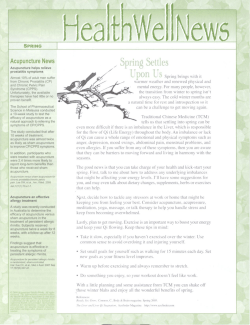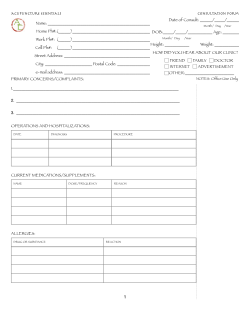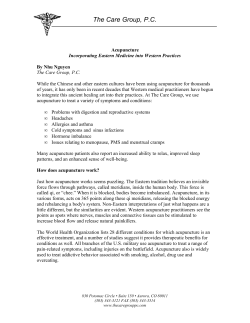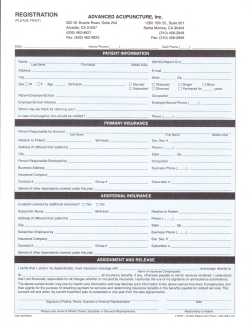
Acupuncture for Pain
Acupuncture for Pain Physical pain is a common occurrence for many Americans; in fact, a national survey found that more than one-quarter of U.S. adults had recently experienced some sort of pain lasting more than a day. In addition to conventional treatments, such as over-the-counter and prescription medications, people may try acupuncture in an effort to relieve pain. This fact sheet provides basic information about pain and acupuncture, summarizes scientific research on acupuncture for specific kinds of pain, and suggests sources for additional information. Key Points People use acupuncture for various types of pain. Back pain is the most commonly reported use, followed by joint pain, neck pain, and headache. Acupuncture is being studied for its efficacy in alleviating many kinds of pain. There are promising findings in some conditions, such as chronic low-back pain and osteoarthritis of the knee; but, for most other conditions, additional research is needed. The National Center for Complementary and Alternative Medicine (NCCAM) sponsors a wide range of acupuncture research. Acupuncture is generally considered safe when performed correctly. In traditional Chinese medicine theory, acupuncture regulates the flow of qi (vital energy) through the body. Research to test scientific theories about how acupuncture might work to relieve pain is under way. Tell all your health care providers about any complementary and alternative practices you use. Give them a full picture of what you do to manage your health. This will help ensure coordinated and safe care. For tips about talking with your health care providers about complementary and alternative medicine (CAM), see NCCAM’s Time to Talk campaign at nccam.nih.gov/timetotalk/. About Pain Pain is a feeling triggered in the nervous system. It may be sharp or dull, off-and-on or steady, localized (such as back pain) or all over (such as muscle aches from the flu). Sometimes, pain alerts us to injuries and illnesses that need attention. Although pain usually goes away once the underlying problem is addressed, it can last for weeks, months, or even years. Chronic pain may be due to an ongoing condition (such as arthritis) or to abnormal activity in pain-sensing regions of the brain, or the cause may not be known. To relieve their pain, many people take over-the-counter medications—either acetaminophen or nonsteroidal anti-inflammatory drugs (NSAIDs, including aspirin, naproxen, and ibuprofen). Stronger medications, including NSAIDs in higher dosages and narcotics, are available by prescription only. People may also try non-drug approaches to help relieve their pain. Examples include physical and occupational therapy, cognitive behavioral therapy, self-care techniques, and CAM therapies such as spinal manipulation or acupuncture. Use of Acupuncture for Pain Acupuncture, among the oldest healing practices in the world, is part of traditional Chinese medicine. Acupuncture practitioners stimulate specific points on the body—most often by inserting thin needles through the skin. In traditional Chinese medicine theory, this regulates the flow of qi (vital energy) along pathways known as meridians. According to the 2007 National Health Interview Survey, which included a comprehensive survey of CAM use by Americans, 1.4 percent of respondents (an estimated 3.1 million Americans) said they had used acupuncture in the past year. A special analysis of acupuncture data from an earlier NHIS found that pain or musculoskeletal complaints accounted for 7 of the top 10 conditions for which people use acupuncture. Back pain was the most common, followed by joint pain, neck pain, severe headache/migraine, and recurring pain. What the Science Says About Acupuncture for Pain Acupuncture has been studied for a wide range of pain conditions, such as postoperative dental pain, carpal tunnel syndrome, fibromyalgia, headache, low-back pain, menstrual cramps, myofascial pain, osteoarthritis, and tennis elbow. Overall, it can be very difficult to compare acupuncture research results from study to study and to draw conclusions from the cumulative body of evidence. This is because studies may use different acupuncture techniques (e.g., electrical vs. manual), controls (comparison groups), and outcome measures. One particularly complex factor in acupuncture research is choosing the controls for a clinical trial. The choice depends in part on whether the researchers want to study a particular aspect of acupuncture (e.g., effects on the brain) or to determine whether acupuncture is useful compared with other forms of care. Examples of control groups include study participants who receive no acupuncture, simulated acupuncture (procedures that mimic acupuncture, sometimes also referred to as “placebo” or “sham”), or other treatments (in addition to or in place of acupuncture or simulated acupuncture). An emerging theme in acupuncture research is the role of the placebo. For example, a 2009 systematic review of research on the pain-relieving effects of acupuncture compared with placebo (simulated) or no acupuncture was inconclusive. The reviewers found a small difference between acupuncture and placebo and a moderate difference between placebo and no acupuncture; the effect of placebo acupuncture varied considerably, and the effect of acupuncture appeared unrelated to the specific kind of placebo procedure used. All of the study participants received standard care, typically consisting of analgesic drugs and physical therapy. 2 The following sections summarize research on acupuncture for a variety of pain conditions, including those reported by NHIS respondents who had used acupuncture. In general, acupuncture appears to be a promising alternative for some of these pain conditions; however, further research is needed. About Scientific Evidence on CAM Therapies Scientific evidence on CAM therapies includes results from laboratory research as well as clinical trials (studies in people). It encompasses both “positive” findings (evidence that a therapy may work) and “negative” findings (evidence that it probably does not work or that it may be unsafe). Scientific journals publish study results, as well as review articles that evaluate the evidence as it accumulates; fact sheets from NCCAM—like this one—base information about CAM research primarily on the most rigorous review articles, known as systematic reviews and meta-analyses. Carpal tunnel syndrome—Although a 1997 NIH consensus statement on acupuncture concluded that acupuncture was promising for carpal tunnel syndrome, additional research confirming acupuncture’s efficacy for this condition is scant. Fibromyalgia—Evidence on acupuncture for fibromyalgia is mixed. Some reviews of the scientific literature have found the evidence promising. However, another review that focused on the few rigorous randomized controlled trials on acupuncture as an adjunct therapy for fibromyalgia did not find a benefit. Additionally, a 2003 assessment by the Agency for Healthcare Research and Quality concluded that the evidence was insufficient and the beneficial effects of acupuncture for fibromyalgia could not be determined. Headache/migraine—Study results on acupuncture for headache are conflicting. Some literature reviews found evidence to support the use of acupuncture for headache, but others noted that most of the studies were of poor quality. A 2008 review of randomized trials on acupuncture highlighted a few well-designed trials whose findings indicate that acupuncture reduces migraine symptoms and is as effective as headache medications. In addition, a 2009 review found that acupuncture may help relieve tension headaches. However, two large trials that looked at acupuncture for migraines found no difference between actual and simulated acupuncture, both of which were equal to conventional care or superior to no treatment. Low-back pain—According to clinical practice guidelines issued by the American Pain Society and the American College of Physicians in 2007, acupuncture is one of several CAM therapies physicians should consider when patients with chronic low-back pain do not respond to conventional treatment. In early, small studies, combining actual acupuncture with conventional treatment was more effective than conventional treatment alone for relieving chronic low-back pain; but actual acupuncture was not more effective than simulated acupuncture or conventional treatment. However, a large, rigorously designed clinical trial reported in May 2009 found that actual acupuncture and simulated acupuncture were equally effective—and both were more effective than conventional treatment—for relieving chronic low-back pain. There is insufficient evidence to draw definite conclusions about the effectiveness of acupuncture for acute low-back pain. 3 Menstrual cramps—Two literature reviews have suggested that acupuncture may help with pain from menstrual cramps, but the research is limited. Myofascial pain—The evidence for acupuncture and myofascial pain (in which pain occurs in sensitive areas, known as trigger points, in the muscles) is mixed. Some literature reviews have found the evidence promising, but another review indicated that “needling therapies” for myofascial trigger point pain were not more effective than placebo. Neck pain—Studies of acupuncture for chronic neck pain have found that acupuncture provided better pain relief than some simulated treatments. However, the studies varied in terms of design and most had small sample sizes. Osteoarthritis/knee pain—Acupuncture appears to be effective for osteoarthritis, particularly in the area of knee pain. Recent literature reviews have found that acupuncture provides pain relief and improves function for people with osteoarthritis of the knee. However, authors of a 2007 systematic literature review suggested that although some large, high-quality trials have shown that acupuncture may be effective for osteoarthritis of the knee, differences in the design, size, and protocol of the studies make it hard to draw any definite conclusions from the body of research. These authors concluded that it is too soon to recommend acupuncture as a routine part of care for patients with osteoarthritis. Postoperative dental pain—Although recent data on acupuncture for postoperative dental pain are scant, literature reviews based on earlier evidence have identified acupuncture as a promising treatment for dental pain—especially pain following tooth extraction. For example, a 1999 study of 39 dental surgery patients found that acupuncture was superior to placebo (simulated acupuncture) in preventing postoperative pain. However, a 2005 study of 200 dental surgery patients found no significant analgesic effect for acupuncture compared to simulated acupuncture, although patients who believed they received acupuncture reported significantly less pain than those who believed they received a placebo. Tennis elbow—Study results on the use of acupuncture for tennis elbow (lateral epicondyle) pain are mixed. An early review of clinical trials reported that data on acupuncture for lateral epicondyle pain were insufficient and of poor quality; however, recent reviews have found the evidence promising, noting strong evidence that acupuncture provides short-term pain relief for lateral epicondyle pain. Acupuncture has also been studied for a variety of other pain conditions, including arm and shoulder pain, pregnancy-related pelvic and back pain, and temporomandibular joint (jaw) dysfunction. Although some studies have produced some positive results, more evidence is needed to determine the efficacy of acupuncture for any of these conditions. There is evidence that people’s attitudes about acupuncture can affect outcomes. In a 2007 study, researchers analyzed data from four clinical trials of acupuncture for various types of chronic pain. Participants had been asked whether they expected acupuncture to help their pain. In all four trials, those with positive expectations reported significantly greater pain relief. In addition to studying acupuncture’s efficacy, researchers are looking at potential biomechanisms—that is, how acupuncture might work to relieve pain. There are several theories about these biomechanisms (e.g., acupuncture activates opioid systems in the brain that respond to pain); additional research is still needed to test the theories. Researchers are 4 using neuroimaging techniques such as functional magnetic resonance imaging (fMRI) to look at the effects of acupuncture on various regions of the brain. In 2005, NCCAM sponsored the “Neurobiological Correlates of Acupuncture” conference to discuss research challenges and directions in acupuncture neuroimaging research. Side Effects and Risks Acupuncture is generally considered safe when performed by an experienced practitioner using sterile needles. Relatively few complications from acupuncture have been reported. Serious adverse events related to acupuncture are rare, but include infections and punctured organs. Additionally, there are fewer adverse effects associated with acupuncture than with many standard drug treatments (such as anti-inflammatory medication and steroid injections) used to manage painful musculoskeletal conditions like fibromyalgia, myofascial pain, osteoarthritis, and tennis elbow. NCCAM-Funded Research NCCAM funds clinical trials to evaluate acupuncture’s efficacy in alleviating various kinds of pain, as well as research aimed at understanding the body’s response to acupuncture and how acupuncture might work. The following are examples of recent projects: Several studies of acupuncture for low-back pain (including integration with conventional medical care) and osteoarthritis of the knee (including cost-effectiveness and long-term results) Studies of acupuncture for pain after oral surgery, and for pain associated with chronic headaches, fibromyalgia, repetitive strain injury/carpal tunnel syndrome, and temporomandibular joint disorder Women’s health studies, including acupuncture for pelvic pain, menstrual pain (vitamin K injections at acupuncture points), and pain associated with advanced ovarian cancer Several studies using fMRI technology to study brain activity during acupuncture, including in people with pain conditions such as fibromyalgia and osteoarthritis. Selected References Barnes PM, Bloom B, Nahin R. Complementary and alternative medicine use among adults and children: United States, 2007. CDC National Health Statistics Report #12. 2008. Birch S, Hesselink JK, Jonkman FA, et al. Clinical research on acupuncture. Part 1. What have reviews of the efficacy and safety of acupuncture told us so far? Journal of Alternative and Complementary Medicine. 2004;10(3):468-480. Burke A, Upchurch DM, Dye C, et al. Acupuncture use in the United States: findings from the National Health Interview Survey. Journal of Alternative and Complementary Medicine. 2006;12(7):639-648. Ernst E. Acupuncture—a critical analysis. Journal of Internal Medicine. 2006;259(2):125-137. Lao L, Hamilton GR, Fu J, et al. Is acupuncture safe? A systematic review of case reports. Alternative Therapies in Health and Medicine. 2003;9(1):72-83. Linde K, Witt CM, Streng A, et al. The impact of patient expectations on outcomes in four randomized controlled trials of acupuncture in patients with chronic pain. Pain. 2007;128(3):264-271. Madsen MV, Gøtzsche PC, Hróbjartsson A. Acupuncture treatment for pain: systematic review of randomized clinical trials with acupuncture, placebo acupuncture, and no acupuncture groups. BMJ. 2009;338:a3115. MacPherson H, Nahin R, Paterson C, et al. Developments in acupuncture research: big-picture perspectives from the leading edge. Journal of Alternative and Complementary Medicine. 2008:14(7):883-887. Napadow V, Ahn A, Longhurst J, et al. The status and future of acupuncture clinical research. Journal of Alternative and Complementary Medicine. 2008:14(7):861-869. 5 Napadow V, Webb JM, Pearson N, et al. Neurobiological correlates of acupuncture: November 17-18, 2005. Journal of Alternative and Complementary Medicine. 2006;12(9):931-935. National Center for Health Statistics. Health, United States, 2006, With Chartbook on Trends in the Health of Americans. Special feature: pain. Hyattsville, MD: National Center for Health Statistics; 2006:68-87. National Institutes of Health Consensus Panel. Acupuncture: NIH Consensus Development Conference Statement, Nov. 3-5, 1997. 15(5):1-34. Park J, Linde K, Manheimer E, et al. The status and future of acupuncture clinical research. Journal of Alternative and Complementary Medicine. 2008;14(7):871-881. Carpal Tunnel Syndrome Muller M, Tsui D, Schnurr R, et al. Effectiveness of hand therapy interventions in primary management of carpal tunnel syndrome: a systematic review. Journal of Hand Therapy. 2004;17(2):210-228. Fibromyalgia Agency for Healthcare Research and Quality. Technology Assessment: Acupuncture for Fibromyalgia. Rockville, MD: Agency for Healthcare Research and Quality; 2003. Assefi NP, Sherman KJ, Jacobsen C, et al. A randomized clinical trial of acupuncture compared with sham acupuncture in fibromyalgia. Annals of Internal Medicine. 2005;143(1):10-21. Harris RE, Gracely RH, McLean SA, et al. Comparison of clinical and evoked pain measures in fibromyalgia. The Journal of Pain: Official Journal of the American Pain Society. 2006;7(7):521-527. Harris RE, Tian X, Williams DA, et al. Treatment of fibromyalgia with formula acupuncture: investigation of needle placement, needle stimulation, and treatment frequency. Journal of Alternative and Complementary Medicine. 2005;11(4):663-671. Mayhew E, Ernst E. Acupuncture for fibromyalgia—a systematic review of randomized clinical trials. Rheumatology (Oxford). 2007;46(5):801-804. Headache/Migraine Coeytaux RR, Kaufman JS, Kaptchuk TJ, et al. A randomized, controlled trial of acupuncture for chronic daily headache. Headache. 2005;45(9):1113-1123. Diener HC, Kronfeld K, Boewing G, et al. Efficacy of acupuncture for the prophylaxis of migraine: a multicentre randomized controlled clinical trial. Lancet Neurology. 2006;5(4):310-316. Endres HG, Diener HC, Molsberger, et al. Role of acupuncture in the treatment of migraine. Expert Review of Neurotherapeutics. 2007;7(9):1121-1134. Griggs C, Jensen J. Effectiveness of acupuncture for migraine: critical literature review. Journal of Advanced Nursing. 2006 May;54(4):491-501. Linde K, Allais G, Brinkhaus B, et al. Acupuncture for tension-type headache. Cochrane Database of Systematic Reviews. 2009;(1):CD007587. Accessed at http://www.cochrane.org on March 27, 2009. Linde K, Streng A, Jürgens S, et al. Acupuncture for patients with migraine: a randomized controlled trial. Journal of the American Medical Association. 2005;293(17):2118-2125. Melchart D, Streng A, Hoppe A, et al. Acupuncture in patients with tension-type headache: randomized controlled trial. BMJ. 2005;331:376-382. Low-Back Pain Chou R, Qaseem A, Snow V, et al. Diagnosis and treatment of low back pain: a joint clinical practice guideline from the American College of Physicians and the American Pain Society. Annals of Internal Medicine. 2007;147(7):478-491. Eisenberg DM, Post DE, Davis RB, et al. Addition of choice of complementary therapies to usual care for acute low back pain: a randomized controlled trial. Spine. 2007;32(2):151-158. Furlan AD, van Tulder M, Cherkin D, et al. Acupuncture and dry-needling for low back pain: an updated systematic review within the framework of the Cochrane collaboration. Spine. 2005;30(8):944-963. Manheimer E, White A, Berman B, et al. Meta-analysis: acupuncture for low back pain. Annals of Internal Medicine. 2005;142(8):651-663. Menstrual Cramps Proctor ML, Smith CA, Farquhar CM, et al. Transcutaneous electrical nerve stimulation and acupuncture for primary dysmenorrhoea. Cochrane Database of Systematic Reviews. 2002;(1):CD002123. Accessed at http://www.cochrane.org on March 27, 2009. White AR. A review of controlled trials of acupuncture for women’s reproductive health care. The Journal of Family Planning and Reproductive Health Care. 2003;29(4):233-236. 6 Witt CM, Reinhold T, Brinkhaus B, et al. Acupuncture in patients with dysmenorrhea: a randomized study on clinical effectiveness and cost-effectiveness in usual care. American Journal of Obstetrics and Gynecology. 2008;198(2):166.e1-166.e8. Myofascial Pain Cummings TM, White AR. Needling therapies in the management of myofascial trigger point pain: a systematic review. Archives of Physical Medicine and Rehabilitation. 2001;82(7):986-992. Neck Pain Trinh KV, Graham N, Gross AR, et al. Cervical Overview Group. Acupuncture for neck disorders. Cochrane Database of Systematic Reviews. 2006;3:CD004870. Accessed at http://www.cochrane.org on March 27, 2009. Osteoarthritis/Knee Pain Agency for Healthcare Research and Quality. Technology Assessment: Acupuncture for Osteoarthritis. Rockville, MD: Agency for Healthcare Research and Quality; 2003. Berman BM, Lao L, Langenberg P, et al. Effectiveness of acupuncture as adjunctive therapy in osteoarthritis of the knee: a randomized, controlled trial. Annals of Internal Medicine. 2004;141(12):901-910. Bjordal JM, Johnson MI, Lopes-Martins RA, et al. Short-term efficacy of physical interventions in osteoarthritic knee pain. A systematic review and meta-analysis of randomised placebo-controlled trials. BMC Musculoskeletal Disorders [online journal]. 2007; 8:51. Accessed at http://www.biomedcentral.com/1471-2474/8/51 on July 30, 2008. Foster NE, Thomas E, Barlas P, et al. Acupuncture as an adjunct to exercise based physiotherapy for osteoarthritis of the knee: randomised controlled trial. BMJ. [online journal]. 2007;335(7617):436. Accessed at http://www.bmj.com/cgi/content/full/335/7617/436 on July 30, 2008. Kwon YD, Pittler MH, Ernst E. Acupuncture for peripheral joint osteoarthritis: a systematic review and meta-analysis. Rheumatology (Oxford). 45(11):1331-1337. Manheimer E, Linde K, Lao L, et al. Meta-analysis: acupuncture for osteoarthritis of the knee. Annals of Internal Medicine. 2007;146(12):868-877. Scharf H-P, Mansmann U, Streitberger K, et al. Acupuncture and knee osteoarthritis: a three-armed randomized trial. Annuals of Internal Medicine. 2006;145(1):12-20. White A, Foster NE, Cummings M, et al. Acupuncture treatment for chronic knee pain: a systematic review. Rheumatology (Oxford). 2007;46(3):384-390. Postoperative Dental Pain Bausell RB, Lao L, Bergman S, et al. Is acupuncture analgesia an expectancy effect? Preliminary evidence based on participants’ perceived assignments in two placebo-controlled trials. Evaluation and the Health Professions. 2005:28(1):9-26. Lao L, Bergman S, Hamilton GR, et al. Evaluation of acupuncture for pain control after oral surgery: a placebocontrolled trial. Archives of Otolaryngology—Head & Neck Surgery. 1999;125(5):567-572. Rosted P. The use of acupuncture in dentistry: a review of the scientific validity of published papers. Oral Diseases. 1998;4(2):100-104. Tennis Elbow Bisset L, Paungmali A, Vicenzino B, et al. A systematic review and meta-analysis of clinical trials on physical interventions for lateral epicondylalgia. British Journal of Sports Medicine. 2005;39(7):411-422. Green S, Buchbinder R, Barnsley L, et al. Acupuncture for lateral elbow pain. Cochrane Database of Systematic Reviews. 2002;(1):CD003527. Accessed at http://www.cochrane.org on March 27, 2009. Trinh KV, Phillips SD, Ho E, et al. Acupuncture for the alleviation of lateral epicondyle pain: a systematic review. Rheumatology (Oxford). 2004;43(9):1085-1090. Trudel D, Duley J, Zastrow I, et al. Rehabilitation for patients with lateral epicondylitis: a systematic review. Journal of Hand Therapy: Official Journal of the American Society of Hand Therapists.2004;17(2):243-266. Other Pain Conditions Ee CC, Manheimer E, Pirotta MV, et al. Acupuncture for pelvic and back pain in pregnancy: a systematic review. American Journal of Obstetrics and Gynecology. 2008;198(3):254-259. Ernst E, White AR. Acupuncture as a treatment for temporomandibular joint dysfunction: a systematic review of randomized trials. Archives of Otolaryngology—Head & Neck Surgery. 1999;125(3):269-272. Goldman RH, Stason WB, Park SK, et al. Acupuncture for treatment of persistent arm pain due to repetitive use: a randomized controlled clinical trial. The Clinical Journal of Pain. 2008;24(3):211-218. Green S, Buchbinder R, Hetrick S. Acupuncture for shoulder pain. Cochrane Database of Systematic Reviews. 2005;(2):CD005319. Accessed at http://www.cochrane.org on March 27, 2009. 7 For More Information NCCAM Clearinghouse The NCCAM Clearinghouse provides information on CAM and NCCAM, including publications and searches of Federal databases of scientific and medical literature. The Clearinghouse does not provide medical advice, treatment recommendations, or referrals to practitioners. Toll-free in the U.S.: 1–888–644–6226 TTY (for deaf and hard-of-hearing callers): 1–866–464–3615 Web site: nccam.nih.gov E-mail: info@nccam.nih.gov PubMed® A service of the National Library of Medicine (NLM), PubMed contains publication information and (in most cases) brief summaries of articles from scientific and medical journals. CAM on PubMed®, developed jointly by NCCAM and NLM, is a subset of the PubMed system and focuses on the topic of CAM. Web site: www.ncbi.nlm.nih.gov/sites/entrez CAM on PubMed®: nccam.nih.gov/research/camonpubmed/ ClinicalTrials.gov ClinicalTrials.gov is a database of information on federally and privately supported clinical trials (research studies in people) for a wide range of diseases and conditions. It is sponsored by the National Institutes of Health and the U.S. Food and Drug Administration. Web site: www.clinicaltrials.gov Research Portfolio Online Reporting Tool (RePORT) RePORTER is a database of information on federally funded scientific and medical research projects being conducted at research institutions. Web site: projectreporter.nih.gov/reporter.cfm Acknowledgments NCCAM thanks the following people for their technical expertise and review of this publication: Ted Kaptchuk, O.M.D., Harvard Medical School; Lixing Lao, Ph.D., University of Maryland Center for Integrative Medicine; Vitaly Napadow, Ph.D., Athinoula A. Martinos Center for Biomedical Imaging, Massachusetts General Hospital; and Partap Khalsa, D.C., Ph.D., and Richard Nahin, Ph.D., M.P.H., NCCAM. This publication is not copyrighted and is in the public domain. Duplication is encouraged. NCCAM has provided this material for your information. It is not intended to substitute for the medical expertise and advice of your primary health care provider. We encourage you to discuss any decisions about treatment or care with your health care provider. The mention of any product, service, or therapy is not an endorsement by NCCAM. National Institutes of Health U.S. Department of Health and Human Services D435 Created May 2009 Updated August 2010
© Copyright 2025









